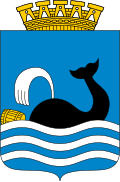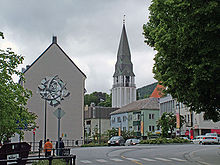Molde
| coat of arms | map | |
|---|---|---|

|
|
|
| Basic data | ||
| Commune number : | 1506 | |
| Province (county) : | Møre and Romsdal | |
| Administrative headquarters: | Molde | |
| Coordinates : | 62 ° 44 ′ N , 7 ° 10 ′ E | |
| Height : | 130 moh. | |
| Surface: | 1,503.36 km² | |
| Residents: | 31,967 (Feb 27, 2020) | |
| Population density : | 21 inhabitants per km² | |
| Language form : | neutral | |
| Website: | ||
| politics | ||
| Mayor : | Torgeir Dahl ( H ) (2011) | |
| Location in the province of Møre og Romsdal | ||

|
||
Molde is a city in Norway and the administrative center of Fylke Møre og Romsdal .
Location and dates
The city of Molde is located on the north bank of the Moldefjord . The main occupation of the inhabitants is traditional industry, in particular the production of furniture and lights (Glamox). Molde is also known as Rosenes by , ie “City of Roses”, because the relatively mild climate means that roses still grow here that actually have their growth limit further south. Chestnuts, maples, linden trees, oaks, red beeches and ash trees also grow here. The reason for this unusual vegetation is an extension of the Gulf Stream in conjunction with the protected location on the fjord. South of the city is a small archipelago with archipelago islands such as Bjørsetholmen and Reknesholmen .
The city’s structural fabric is mostly recent, as Molde, the last headquarters of the Norwegian army, was largely destroyed by German forces in 1940 . Molde has been a student city since the University of Molde was founded in 1994.
history
The name of the city is derived from the Norwegian word for topsoil - "Mold" - as the first settlers found unusually fertile soil here. The current city of Molde was founded in the middle of the 15th century. In addition to wood production, it was mainly the export of herrings that made the city grow rapidly. In 1742 Molde received city rights. During the Second World War , the city was almost completely destroyed by the German air force . Since the 1950s, the city has presented itself as a modern city with numerous well-tended gardens.
As part of the municipal reform in Norway , Midsund and Nesset were integrated into Molde on January 1, 2020.
Events
Since 1961 the nationally known jazz festival Moldejazz has taken place here annually , which attracts thousands of musicians and tourists. In addition to the Jazz Festival, there is also the Bjørnson Festival , which is very interesting for internationally renowned authors and which brings them to Molde.
traffic
Molde has been the landing stage for Hurtigruten ships for over 100 years . This is where the north- and south-facing ships meet in the harbor every evening. Arø Airport, which is not far from the city, is one of the largest regional airports in the country with around 300,000 passengers per year. Molde is close to the Atlantic Road , a route popular with tourists.
Sports
The city's best-known sports clubs are Molde Fotballklubb and Molde Håndballklubb .
Attractions
The city's current structure was largely created after the end of the Second World War, as Molde was largely destroyed by German forces in 1940 as the last quarter of the Norwegian King Haakon VII . The so-called royal birch is a reminder of the German occupation of Norway in World War II.
The altarpiece of the previous church, which was destroyed in 1940, hangs in the cathedral church, newly built in 1957, with the distinctive free-standing bell tower. The centrally located Reknesparken with a monument to the writer Alexander Kielland is just as worth seeing as the Romsdalenmuseum , an open-air museum with 35 reconstructed historical buildings from the province of Møre og Romsdal , including a historical urban street. In 2016 the new wooden central building "Krona" ("Die Krone") was opened. It houses a newly designed permanent exhibition, a library, a concert hall and the Mali café. A section of the museum dedicated to fishing is on the fjord island of Hjertøya, to which excursion boats leave from Torget (market) in summer.
The mountain Varden ( 407 moh. ) Offers a good view of Molde as well as the 696 moh. high inks. Not only these two mountains characterize the region around Molde, but a total of 222 mountain peaks, some of which are snow-capped, ensure a unique landscape and an impressive panorama. To the north of the city is the local recreation and hiking area of Moldemarka with its vegetation, which is unusually rich for this region.
The most striking building on the lake side of the city is the glass structure of the Scandic Seilet Hotel, whose architecture is reminiscent of the shape of a sailing ship.
Town twinning
Molde has the following twin cities :
|
sons and daughters of the town
- Nini Roll Anker (1873–1942), author
- Kurt Asle Arvesen (* 1975), racing cyclist
- Håvard Bjerkeli (* 1977), cross-country skier
- Kjell Magne Bondevik (* 1947), politician
- Ane Brun (* 1976), songwriter
- Ole Christian Eidhammer (* 1965), ski jumper
- Per Kjetil Farstad (* 1952), musicologist, lute virtuoso
- Andrine Flemmen (* 1974), ski racer
- Lars Hansen (1869-1944), writer
- Daniel Herskedal (* 1982), jazz musician
- Marianne Kjørstad (* 1970), ski racer
- Ole Christian Kvarme (* 1948), Bishop of Oslo
- Ingolf Mork (1947–2012), ski jumper
- Ragnhild Mowinckel (* 1992), ski racer
- Paal Nilssen-Love (* 1974), jazz drummer
- Kjetil André Rekdal (* 1968), football player and coach
- Trine Bakke (* 1975), ski racer
- Kjell Inge Røkke (* 1958), businessman
- Jim Svenøy (* 1972), obstacle runner
- Stian Vatne (* 1974), handball player
- Terje Venaas (* 1947), jazz bassist
Persons connected to Molde
- In Molde, the Nobel Prize winner Bjørnstjerne Bjørnson attended school.
- Henrik Ibsen spent his holidays here several times.
- Alexander Kielland , a Norwegian poet, lived here and was president of the province of Møre og Romsdal.
- From 1889 to 1914, with the exception of 1905, Kaiser Wilhelm II spent the summer in the Fiordland and Molde.
- The poet and writer Kurt Schwitters (Dadaism) spent several summers on the island of Hjertøya off Molde. Today there is a small Schwitters museum there.
- The painter and poet Kurt Schwitters lived here at the end of the 1930s .
Web links
- City website (Norwegian)
- Website of the Tourist Info Region Molde (Norwegian and English)
- Molde Jazz Festival
- Pictures from Molde and Romsdal
- Romsdalen Museum website (Norwegian)
- Slide show Romsdalenmuseum Duration: 3:26
- Slide show View from Varden Duration: 1:35
- Slideshow Around the Church Duration: 0:56
- Tourist Office Norway
proof
- ↑ Statistisk sentralbyrå - Befolkning
- ↑ a b Molde Bymuseum: Om Molde as of July 24, 2013.
- ↑ Navn på nye kommuner. February 19, 2019, accessed January 22, 2020 (Norwegian).





